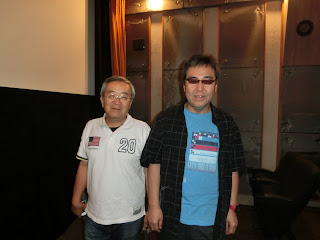 |
| Hiroshi Kashiwabara. Photo by Brett Homenick. |
On Sunday, SEptember 26, I attended yet another special event featuring a reunion of luminaries from the hit crime drama Abumai Deka (1986-87). This reunion featured scriptwriter Hiroshi Kashiwabara, director Toru Murakawa, and actress Kanae Hasebe.
Kashiwabara-san, as most readers of this blog will no doubt remember, wrote the screenplays for Godzilla vs. Space Godzilla (1994), Godzilla 2000 (1999), and Godzilla vs. Megaguirus (2000). Of course, the recent passing of Wataru Mimura was a topic of conversation.
 |
| Toru Murakawa. Photo by Brett Homenick. |
Director Toru Murakawa is a director best known for his many collaborations with actor Yusaku Matsuda. Murakawa-san directed the films The Resurrection of the Golden Wolf (1979) and The Beast to Die (1980), both of which star Matsuda. On the small screen, he directed episodes of Daitsuiseki (1978) and Tantei Monogatari (1979-80). However, I know Murakawa-san best as the chief assistant director of the Japanese scenes of Tora! Tora! Tora! (1970).
 |
| Kanae Hasebe. Photo by Brett Homenick. |
It's not very common that a guest at one of these events asks to take a picture with you, but that's exactly what Hasebe-san did after we took the above photo. Suffice it to say, I was quite flattered when she asked another attendee to take our picture on her phone. Afterward, we spoke about the directing work of her father.
I know nothing about Abunai Deka, but these events sure are a lot of fun! Maybe I should start watching the show.




















